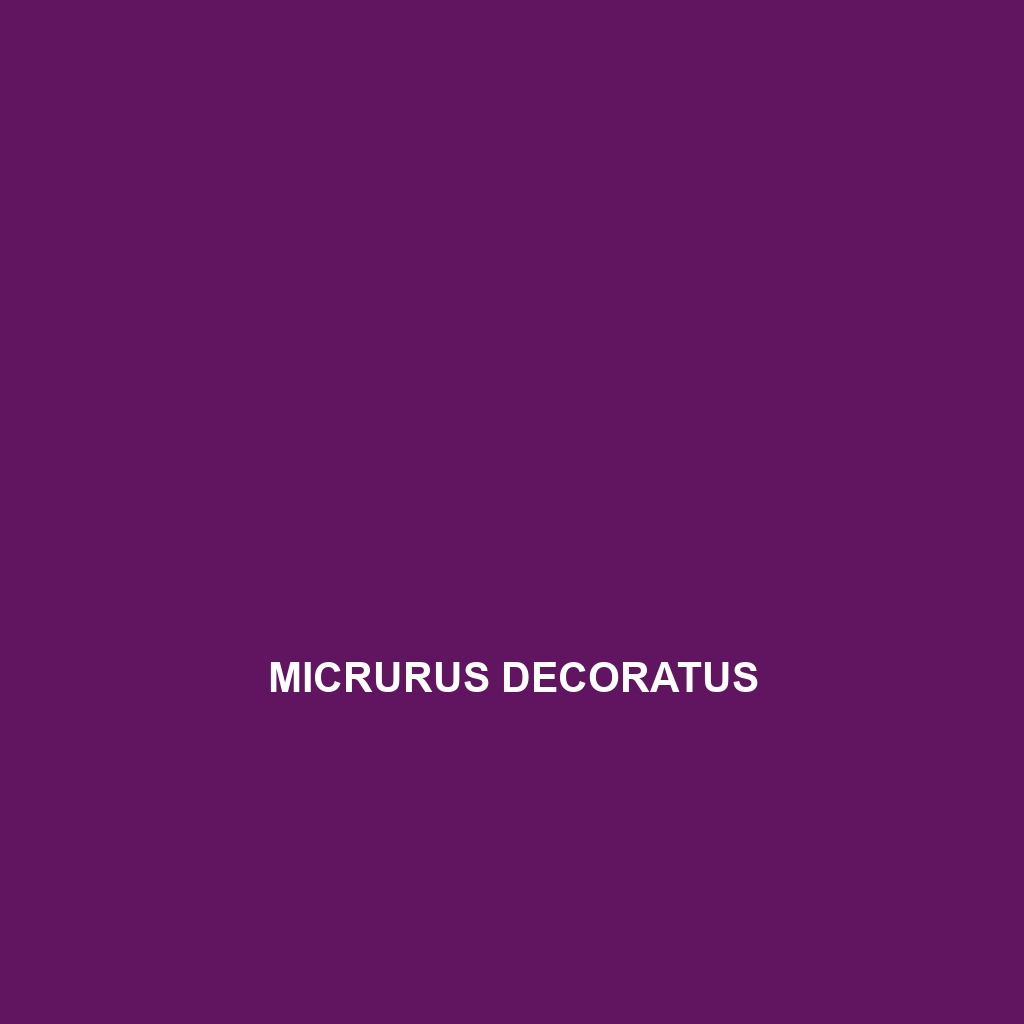Common Name
Micrurus decoratus
Scientific Name
Micrurus decoratus
Habitat
Micrurus decoratus, commonly known as the decorated coral snake, primarily inhabits tropical rainforests and surrounding habitats in Central and South America. This species thrives in humid climates, often found in close proximity to streams and rivers. In addition to rainforests, it can also be spotted in savannas and temperate forests where the dense underbrush provides refuge and hunting grounds. The intricate ecological tapestry of its habitat fosters a rich biodiversity, playing a critical role in the lifecycle of various flora and fauna. Climate fluctuations can affect the populations of Micrurus decoratus, emphasizing the need for careful monitoring and study.
Physical Characteristics
Micrurus decoratus is a strikingly beautiful snake, known for its vibrant coloration and distinctive physical features. Adults typically range from 60 to 100 centimeters in length, making them relatively small compared to other snake species. Their bodies are elongated and slender, adorned with a series of bold, alternating bands of black and vibrant red. These color patterns serve as warning signals to potential predators, indicating their venomous nature. The head is distinctively narrow compared to the body, which further emphasizes its slender build. A unique feature includes the presence of a smooth, shiny scale texture that enhances its striking appearance.
Behavior
Micrurus decoratus exhibits primarily nocturnal behavior, emerging at night to hunt for prey. These snakes are solitary creatures, often avoiding encounters with others of their kind outside mating season. Mating rituals occur during the rainy season, where males will engage in combat to win the favor of females, showcasing a fascinating display of strength and agility. During the day, they tend to seek refuge in hidden places such as logs, leaf litter, and crevices, which helps them avoid predators. Their defensive behavior often includes coiling into a tight ball when threatened, utilizing their cryptic coloration for camouflage.
Diet
Micrurus decoratus is primarily carnivorous, feeding mainly on small reptiles and amphibians. Their diet typically includes lizards and various frog species, which they apprehend using their quick reflexes and sharp fangs. As a member of the Elapidae family, they possess neurotoxic venom that immobilizes their prey quickly. Unlike other snakes, coral snakes have a unique feeding pattern, with their specialized fangs allowing them to deliver venom into their prey without constricting it to death. Observations indicate that they hunt during twilight hours, adapting their feeding strategies to the time of day when their prey is most active.
Reproduction
The reproductive cycle of Micrurus decoratus is fascinating, marked by a specific mating season occurring during the rainy months. After a gestation period of approximately 2-3 months, females typically lay clutches of 3 to 8 eggs in moist, concealed locations. The hatchlings emerge with fully developed venom and exhibit the same striking coloring as adults, indicating their immediate need for camouflage from predators. Parental care is almost nonexistent, with the young relying entirely on their instincts for survival. The rapid development of hatchlings allows them to quickly acclimate to their environment and begin foraging shortly after birth.
Conservation Status
According to the International Union for Conservation of Nature (IUCN), Micrurus decoratus is currently classified as ‘Least Concern’. However, habitat destruction due to deforestation and land conversion poses significant threats to their populations. Conservation efforts focus on protecting their natural habitats, implementing reforestation initiatives, and educating local communities on the ecological significance of preserving this species. Continued monitoring is essential to ensure population stability, particularly in areas heavily affected by human activities.
Interesting Facts
One interesting fact about Micrurus decoratus is its ability to mimic the coloration of non-venomous snakes, a trait that may help it avoid predation. Additionally, this species has a peculiar method of movement known as lateral undulation, enabling it to slither through dense vegetation deftly. Their neurotoxic venom, effective for immobilizing prey, has sparked interest in medical research for potential applications in developing pain relief medications.
Role in Ecosystem
Micrurus decoratus plays a vital role in its ecosystem as both a predator and prey species. As a predator, it helps control populations of small reptiles and amphibians, contributing to the balance of local biodiversity. Furthermore, its presence signifies a healthy environment, indicative of robust food chains and ecological resilience. The decorated coral snake serves as prey for various larger species, continuing a vital cycle of life within the ecosystem. Its role as a keystone species highlights the interconnectedness of species and the importance of conservation efforts to maintain healthy ecosystems.
